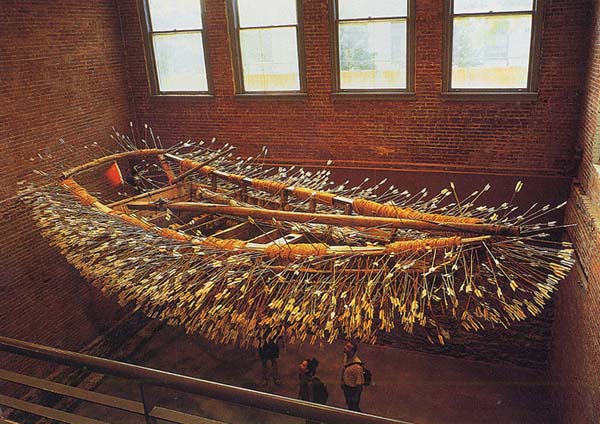In my last post I talked about complexity specifically in the work of Oliver Vernon . His work is merely one example, and lest I appear like a detail junky or something, I should say that the work does come off as a bit epistemically barren. I wouldn't say it's only formalist in its concerns though. Maximalism is interesting in itself as a concept.
Although I could say....
... and that would be interesting. But for something different I thought I'd mention a piece we discussed in Modern Chinese Art History class the other day.
The work of Cai Guo-Qiang's work is fascinating. This piece in particular is based on an ancient Chinese fable about two armies. During a great battle in the 3rd century (I think) one army ran out of arrows. So they devised a clever trick to send over an empty boat in the dead of a foggy night. When the boat reached the other army they reacted and shot innumerable arrows at it. Somehow the first army got it back and retrieved the arrows to use in the next battle.
The implication here is revealed when viewing this piece with its accompanying fable as an analogy for current events. China may be working for very little constructing the disposable dry goods we use in the west with abandon, but they're merely saving up their 'arrows' as it were. Seeing how far China has come since then economically only adds to the work's gravitas. It's a clever use of a fable to make a subtle comment about the present, but it also attempts to mask a peculiar national insecurity. On top of that, it's just a brilliant piece visually. Even without the backstory, arrows and boats are incredibly evocative leaving no end to their interpretation.
I've also thought of his approach as reminiscent of Joseph Beuys' work.
Although I could say....
... and that would be interesting. But for something different I thought I'd mention a piece we discussed in Modern Chinese Art History class the other day.
Cai Guo-Qiang "Borrowing Your Enemy's Arrows" 1998
The work of Cai Guo-Qiang's work is fascinating. This piece in particular is based on an ancient Chinese fable about two armies. During a great battle in the 3rd century (I think) one army ran out of arrows. So they devised a clever trick to send over an empty boat in the dead of a foggy night. When the boat reached the other army they reacted and shot innumerable arrows at it. Somehow the first army got it back and retrieved the arrows to use in the next battle.
The implication here is revealed when viewing this piece with its accompanying fable as an analogy for current events. China may be working for very little constructing the disposable dry goods we use in the west with abandon, but they're merely saving up their 'arrows' as it were. Seeing how far China has come since then economically only adds to the work's gravitas. It's a clever use of a fable to make a subtle comment about the present, but it also attempts to mask a peculiar national insecurity. On top of that, it's just a brilliant piece visually. Even without the backstory, arrows and boats are incredibly evocative leaving no end to their interpretation.
I've also thought of his approach as reminiscent of Joseph Beuys' work.
The Pack 1969
It's an admittedly distant connection, but it's something about the scale and use of objects. Beuys always seemed to imagine himself as a refuge from some utopia as well. I really just enjoy the subtle combination of found objects into larger more lively compositions. Judging from so many inelegant uses of found objects, it's not as easy as it looks. Man, he was such a kook though. Either piece could be great inspiration for world politics/installation based lesson.




0 comments:
Post a Comment